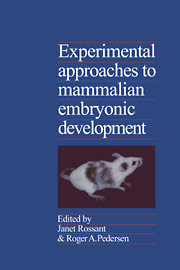Book contents
- Frontmatter
- Contents
- Preface
- Contributors
- Cellular aspects
- Molecular and biochemical aspects
- Toward a genetic understanding of development
- 13 Evidences and consequences of differences between maternal and paternal genomes during embryogenesis in the mouse
- 14 Mutations and chromosomal abnormalities: How are they useful for studying genetic control of early mammalian development?
- 15 Production of permanent cell lines from early embryos and their use in studying developmental problems
- 16 Integration and expression of genes introduced into mouse embryos
- Index
15 - Production of permanent cell lines from early embryos and their use in studying developmental problems
from Toward a genetic understanding of development
Published online by Cambridge University Press: 31 March 2010
- Frontmatter
- Contents
- Preface
- Contributors
- Cellular aspects
- Molecular and biochemical aspects
- Toward a genetic understanding of development
- 13 Evidences and consequences of differences between maternal and paternal genomes during embryogenesis in the mouse
- 14 Mutations and chromosomal abnormalities: How are they useful for studying genetic control of early mammalian development?
- 15 Production of permanent cell lines from early embryos and their use in studying developmental problems
- 16 Integration and expression of genes introduced into mouse embryos
- Index
Summary
Introduction
The first visible differentiation of the mammalian embryo occurs with formation of the blastocyst. At this stage the embryo can be seen to have two distinct cell types: the trophectoderm cells, which have limited developmental capacity that restricts them to the extraembryonic lineages, and the pluripotent inner cell mass (ICM) cells, which give rise to all of the differentiated cell types of the adult, including the germ line (see Chapters 4 and 5). As the ICM cells proliferate, groups of cells become committed to specific developmental pathways. By 7.5 days of development, proliferating pluripotent cells are restricted to the embryonic ectoderm of the egg cylinder, and it is these cells that give rise to the tissues of the adult mouse. The methods for rescuing the undetermined pluripotent cells present during the first 8 days of embryonic development and the establishment of permanent tissue culture lines from them are the subjects of this chapter.
Isolating cell lines from embryos into tissue culture provides an opportunity to perpetuate a given cell phenotype indefinitely. Permanent cell lines established under in vitro conditions provide large quantities of homogeneous material that can be used for biochemical analysis of the patterns of gene expression. Embryo-derived cell lines are becoming increasingly important as sources of material to facilitate molecular investigation of the differentiation processes occurring in the embryo.
Cell lines from embryos can be classified as being of either a differentiated or an undifferentiated stem cell phenotype. Differentiated cell lines are relatively easy to define, both phenotypically and by expression of particular biochemical markers (Sherman 1975; Evans 1981).
- Type
- Chapter
- Information
- Experimental Approaches to Mammalian Embryonic Development , pp. 475 - 508Publisher: Cambridge University PressPrint publication year: 1987



